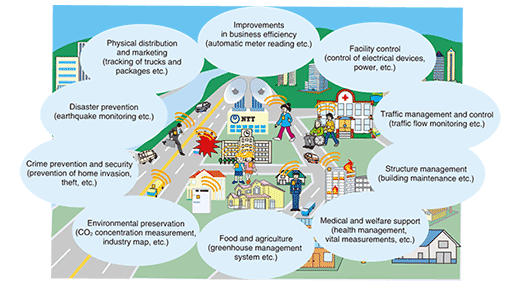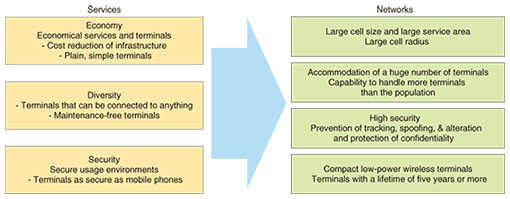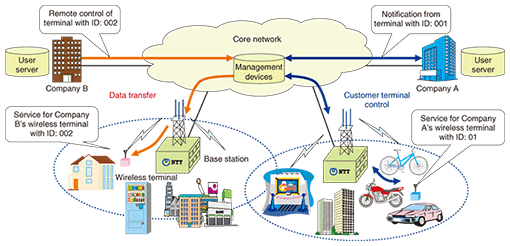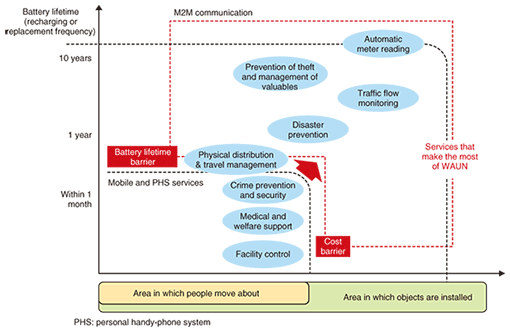 |
|||||||||||||||||||
|
|
|||||||||||||||||||
|
Special Feature: R&D of Wide-area Ubiquitous Network to Create New Services Vol. 8, No. 6, pp. 1–6, June 2010. https://doi.org/10.53829/ntr201006sf1 Wide-area Ubiquitous Network that Allows Communication with ObjectsAbstractThis article describes the system concept of a wide-area ubiquitous network that connects compact wireless terminals economically and allows communication with objects. It also introduces some services that can be provided on this network, discusses the business areas that the network is expected to support, and gives examples of the network’s usage.
1. Introduction1.1 Rise in M2M communication marketAs we look towards the advent of the ubiquitous society, in which a huge number of devices and other objects will be connected to networks, expectations are rising for machine-to-machine (M2M) communication. In this scheme, devices automatically recognize their circumstances and environments, such as the surrounding people and objects, and communicate accordingly through autonomous information sharing. The Fiscal Year 2009 Report from the Radio Policy Panel [1] identified four service fields that will strongly support the future ubiquitous network in Japan: wireless network infrastructure, basic wireless services, application services, and new wireless services. It estimates that the market size of new wireless services based on new ways of using wireless technology, such as M2M communication, will grow rapidly to 9.1 trillion yen (US$98.6 billion) by 2015 and 22.1 trillion yen by 2020. The business areas to which M2M communication services are expected to be applicable are shown in Fig. 1 [2]. Many activities related to M2M communication are currently in progress. For example, the New Urban Society Technology Integration and Creation Study Group is conducting a project that aims to build a road disaster monitoring network system [3] that will collect data from wireless sensor terminals installed on the slopes beside roads. Furthermore, the National Institute of Advanced Industrial Science and Technology has developed an animal health monitoring system, in which small wireless terminals with built-in sensors are attached to animals [4].
As a way to build an efficient and flexible network for connecting such terminals, a wired network is often impractical. In particular, if the objects to which terminals are attached move around, as in the case of the animal health monitoring system, a wireless system is essential. Therefore, the goal is wireless network access for devices and other objects that may be installed in a variety of environments. 1.2 Network and service requirements for M2M communicationsThe requirements that must be met by M2M communication services and by the network are shown in Fig. 2. If inter-object communication services are to grow and become widely used due to their applicability to a variety of situations, they must meet the following requirements: (i) Economy: Services must be available anywhere at low cost. Network cells should have a large radius so that the network can cover a wide area economically. (ii) Diversity: A large amount of wiring should be eliminated so that terminals will be maintenance-free and can be attached to anything. (iii) Security: High security must be ensured even in a mobile environment so that terminals can be connected to the network securely.
To meet these requirements and provide an environment in which anyone can use inter-object communication easily, it is necessary to limit the capability of the terminals in order to reduce their cost. To connect such plain, simple terminals, the network must satisfy the following requirements: (1) Large cell size and large service area To build an environment monitoring system, for example, one must install sensors over a wide area and collect data from all the sensors. In the management of the physical distribution, it is necessary to enlarge the service area to ensure traceability. Furthermore, since most wireless terminals are powered by batteries, it is necessary to reduce the transmission power of terminals. Accordingly, the network must be able to support a large cell size even though the terminal transmission power is low. (2) Accommodation of a huge number of terminals There will be more objects than people in the area to be covered by the network, so the network must be able to accommodate far more terminals than the population. On the other hand, both the frequency of communication and the amount of data communicated in inter-object communication will be relatively low, which means that the percentage of information used for controlling communication will be relatively high. The network must efficiently accommodate terminals that exhibit such traffic characteristics. (3) High security Irrespective of the capability level, each terminal must ensure its own security and that of the information it transfers. The network, as a whole, must achieve a high level of security by preventing tracking, spoofing, and alteration, protecting confidential information, etc. (4) Compact low-power wireless terminals Objects can be installed anywhere. If their batteries needed to be recharged or replaced every a few days, as is the case for mobile phones, the operational cost would be enormous. Therefore, it is necessary to ensure that terminals operate with minimum power consumption and can operate for a long time before their batteries need recharging or replacement. To reduce the operational cost, wireless terminals must be able to operate autonomously for long times of the order of several years. 2. Wide-area ubiquitous networkNTT Laboratories is undertaking research and development of a wide-area ubiquitous network (WAUN) as a wireless communication system that exhibits the characteristics required for M2M communication [5], [6]. The WAUN can provide bidirectional network services, such as the collection of data held by objects and delivery of data to objects, through public gateways. The system consists of a core network, base stations, and wireless terminals. Wireless terminals are compact, economical, and energy-saving because their limited functionality is strongly supplemented by the network and base stations. 2.1 Core networkThe core network is highly scalable so that it can perform authentication, movement management, and data transfer for a huge number of wireless terminals. In addition, it provides the many simple wireless terminals with security capabilities that include countermeasures against spoofing, sniffing, and alteration. 2.2 Base stationsTo enable the system to cover a large service area cost-effectively and to reduce the investment required for the construction of the network, each base station must be able to connect directly to wireless terminals in as large an area as possible. A multihop scheme is unsuitable for a large cell size because it would require wireless terminals with high performance, high functionality and a continuously available power supply, which would make it difficult to provide services at low cost. We have made the cell size large by building base stations using wireless technology that solves the problems associated with wireless transmission, such as phasing and shadowing, and by boosting the reception performance of the base stations. In addition, we have enabled the network to accommodate a huge number of terminals by choosing an access method that efficiently uses access links in the wireless section. Furthermore, we have developed a lightweight communication protocol that reduces bandwidth consumption in the wireless section and the number of signals to be processed by the simple, low-capability, terminals. 2.3 Wireless terminalsWireless terminals have been made inexpensive by limiting their functionality and simplifying their circuitry. In addition, they have been designed to operate at low power; therefore, they can function for a long time without the need for battery recharging or replacement. Their compactness has been improved by reducing the antenna size. To sum up, this wireless communication system features: battery-driven, long-life, wireless terminals, services that are less expensive than existing public wireless services, high security for customer information, and both indoor and outdoor service availability. It is expected to become a platform for the provision of new services and applications that offer features specific to M2M communication. A conceptual representation of services that can be provided on the WAUN is shown in Fig. 3. Wireless terminals are attached to customer terminals (sensors etc.). Each terminal is given a number (service identifier (ID)) belonging to the specific customer (enterprise etc.). The status of each customer terminal can be set or confirmed via its ID. This system provides two representative service functions: (i) Data transfer Sends information to and receives information from each customer terminal for, for example, automatic meter reading, earthquake monitoring, traffic flow monitoring, and electronic bulletin boards. (ii) Customer terminal control Remotely controls customer terminals to reset or switch each terminal’s operating mode etc.
The business areas assumed for M2M communication services are shown in Fig. 4. The low-cost long-life battery-powered terminals enable the deployment of the large number of terminals required for monitoring traffic flows at various locations where a reliable external power suppy might be unavailable. Since the system will be able to provide bidirectional network services even in service areas whereas conventional wireless communication systems, such as the mobile phone system, would be unable to support some aspects of M2M communication, it will help create a new business market.
3. Standardization activitiesOne objective of the WAUN is to provide economical services over a long period. We believe that it is important to standardize the technology used in order to promote market expansion. We are currently working to achieve international standardization of the technology at ITU-R (International Telecommunication Union, Radiocommunication Sector) and domestic adoption of the technology in Japan. To verify the technology and services, we are carrying out a feasibility test of the Next Generation Wireless Communication Network under the auspices of the Ministry of Internal Affairs and Communications (MIC). The test is being conducted in a certain ubiquitous-computing zone (called a “Special Ubiquitous Zone” by MIC) [7]. These activities aim to explore a variety of services and applications and thereby cultivate new markets. In addition, we plan to launch a Wide-Area Sensor Network Committee within the Ubiquitous Networking Forum [8] to study and promote the widespread use of M2M communication and we will study the technical issues identified in the feasibility test. 4. ConclusionWe are undertaking research and development of a wide-area ubiquitous network (WAUN) with the aim of developing it into a social infrastructure that will facilitate the establishment of a safe and secure ubiquitous society. WAUN technologies and the service feasibility test are described in more detail in the other articles in this Special Feature. References
|
|||||||||||||||||||
















